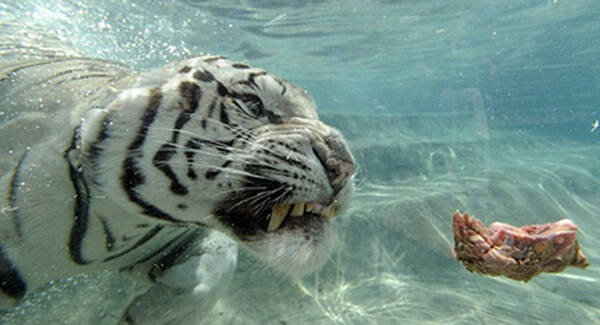Bengal White Tiger
IUCN
LCBasic Information
Scientific classification
- name:Bengal White Tiger
- Scientific Name:Bengal White Tiger,Bengal Tiger (white),Bengal white tiger, white tiger Bengal white tiger, white tiger
- Outline:Carnivora
- Family:Schizopoda Felidae Panthera
Vital signs
- length:About 2-2.3 meters
- Weight:110-210kg
- lifetime:About 20 years
Feature
A variation of the Bengal tiger, with white fur and black, gray or chocolate stripes
Distribution and Habitat
It is native to Yunnan, China, Myanmar, India and Bangladesh, and has a wide range of habitats, including the very high and cold Himalayan coniferous forests, swamp reeds, dry mountains in the Indian Peninsula, and the lush rainforests and dry woods in northern India.
Appearance
The albino Bengal tiger is a variant of the Bengal tiger. Due to a genetic mutation, the Bengal tiger's original orange-yellow fur with black stripes has turned into a white with black stripes. The white Bengal tiger is a variant of the Bengal tiger, with a different color from the regular Bengal tiger, a pink nose, white to cream fur, and black, gray or chocolate stripes. White tigers' eyes are usually blue, but can be green or amber.
Wild white tigers are extremely rare and almost never seen. The average male Bengal tiger is 2.9 meters long from head to tail, and the Bengal tiger weighs 180-210 kilograms; females are slightly smaller, measuring 2.6 meters long and weighing 110-190 kilograms.
Details
The albino Bengal tiger (English name: Bengal White Tiger) is also known as the Bengal white tiger, or "white tiger" for short. It is a variant of the Bengal tiger. Due to a genetic mutation, the Bengal tiger's original orange-yellow hair with black stripes has turned into a white-based black stripe. The first wild Bengal white tiger was discovered and captured in India in 1951 and was named "Mohan". All the hundreds of white tigers in the world are its descendants.

The first wild albino Bengal tiger was discovered in India in 1951 by a local king, Maharaja (meaning "great king"), Martand Singh, who was hunting at the time. The little white tiger was only 9 months old when it was discovered. Martand took this special little tiger back to the palace and named it "Mohan", which means "confusing one". Since then, there have been some reports of sightings of white tigers in the wild, but none of them have been confirmed. The hundreds of white tigers in the world are all its descendants. The Bengal white tiger is a world-class protected animal and a national treasure of India. There are only about 210 white tigers left in the world.
In history, documents from China, South Korea, Nepal and some Southeast Asian countries also record texts about white tigers. In China, the white tiger has become a kind of divine creature, which only appears when the emperor has a virtuous government or when the world is peaceful, so zoos in mainland China are very keen to breed white tigers and other "auspicious animals". Among the four symbols, the white tiger corresponds to the blue dragon and is a spiritual animal representing the West.

Bengal white tigers are often misunderstood as albinos, but this is not the case. Tigers with true albinism do not have stripes. Bengal white tigers have normal black or dark brown stripes. The reason why white tigers have white hair is due to a genetic mutation. The mutated gene is recessive. Even if both parents carry the recessive white allele, there is only a one-in-four chance of giving birth to a white tiger. White tigers are too conspicuous and have difficulty surviving in the wild. Only Bengal tigers are known to have the recessive gene, but many artificially raised white tigers are hybrids of Bengal tigers and Siberian tigers. Due to the limited gene pool, the offspring of a pair of white tigers often have many health problems, such as strabismus and weak resistance.
It is well known that cats are naturally afraid of water. But at the Six Flags Discovery Kingdom in San Francisco, USA, a male Bengal white tiger named Odin is not afraid of water at all, but is famous for his outstanding swimming skills. In 2009, Odin, who was 8 years old, was an adult male Bengal white tiger with snow-white fur and black stripes unique to Bengal tigers. It is 3 meters long and strong. Although it looks scary, it is not so wild because it was raised by humans since childhood. Like all tigers, Odin loves meat. However, the breeder came up with a good idea to put the meat in a glass pool specially built for Odin, so that Odin can stretch his muscles and exercise while enjoying a delicious meal. Not only that, the tourists in the park also enjoyed the scene of Odin diving into the glass pool and concentrating on "looking for meat".

In August 2016, China's Changzhou Yancheng Wildlife Park was suspected of illegally transporting wild animals, and the forestry department intervened in the investigation. According to reports: A few days ago, the Huzhou police in Zhejiang seized three "albino Bengal tigers", a first-class protected animal, from a commercial vehicle with a Changzhou license plate. The driver claimed to be a staff member of a zoo in Changzhou and wanted to transfer three tiger cubs in poor health to Xiamen, Fujian for treatment. The person was unable to provide relevant documents and procedures for transporting wild animals. He also said that the species he carried was a "Persian cat." Modern Express reporters learned from the unit involved, Jiangsu Yancheng Wildlife World (Changzhou Yancheng Zoo), that the three tiger cubs were indeed transferred to Xiamen for treatment due to poor condition, and they forgot to go through the procedures due to the emergency.
On May 27, 2019, in Masaya, Nicaragua, the Masaya National Zoo received two 5-month-old male and female white tigers from Mexico.
Protect wild animals and eliminate game.
Maintaining ecological balance is everyone's responsibility!








